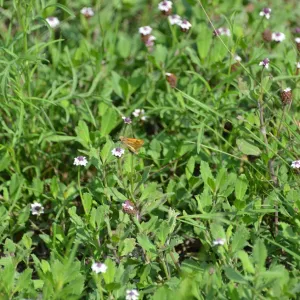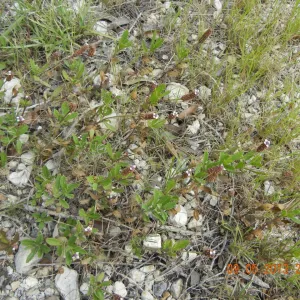by Delmar Cain – Boerne Chapter, Native Plant Society of Texas
Published in the Boerne Star on June 6, 2014
Do you remember when I wrote that someone could make some money with a book about the common names of plants? I have another candidate for the book. Actually several of the common names of this plant deserve some space in the book. The plant is Texas Frogfruit, Turkey Tangle Fogfruit or just Frogfruit (Phyla nodiflora). And although I have made typographical errors before, I did not leave an “r” out of Fogfruit.
The Boerne Chapter of the Native Plant Society of Texas has chosen Texas Frogfruit as the Plant of the Month for June for the NICE Program (Native Instead of Common Exotics). But it will have to be a very special plant to overcome common names like those listed.
Fortunately in my view there is something very special about this plant and one that I can wholeheartedly recommend. For one thing it comes from a good family, the Verbena Family (Verbenaceae). It is the family that also has such stalwarts as Prairie Verbena, Lantana, Bee-Brush and American Beautyberry. Most Hill Country residents who have a landscape will have at least one of those family members. If they don’t have one in their yard, they will pass one if they commute on any public road, since Texas Vervain and Gray Vervain are also in the family. Those last two members are generally found in every public road right of way.

And just like some other members in the family, Texas Frogfruit is no shrinking violet.
I first became acquainted with Frogfruit on weekly nature walks with Patty Leslie Pasztor at the Cibolo Nature Center in Boerne. She was conducting a multi-month butterfly survey for the CNC and anyone who showed an interest was welcome to accompany her.

After walking along the marsh area of the CNC we would also walk on the north side of the prairie grassland area. On the trail itself, which also was the trail for the four-wheeled maintenance vehicles, we would always see a variety of butterflies including several small skippers. These butterflies would hang out on a low-growing plant that grew along the trail in the open areas next to the taller prairie grasses and in the areas between the wheel tracks. After a good rain the plants might be covered in water. In the dry periods the plants would be growing in places where the soil was so dry that it had cracked.

In addition we would find the plant growing in the shade along the banks of Cibolo Creek. But we would also see it growing along the edge of the caliche near the parking lot. This plant was tough enough to take all kinds of conditions and soil. And that is what the Wildflower Center confirms in its description of Frogfruit. It will grow in “sand, loam, clay, caliche and limestone soils”. It tolerates “poor drainage, saline soils, drought and flooding”. The one thing that it does not tolerate is mowing. But since it grows only to 6 or so inches tall, why should that ever be a problem? Leave it alone.
Frogfuit is a native perennial herb that is evergreen except in colder years in Texas, when it may become dormant with its leaves turning purplish. Growing either in full sun or part shade, it has trailing stems that extend from a woody base. In a favorable spot it can form tangled mats. It makes an excellent groundcover and can be grown in pots as well. I planted mine along the edge of a rock terrace where the stems will fall over the edge of the rocks, if the deer would leave them alone.

The blooms on native Texas Frogfruit will not cause you to stop your car for a children’s photo opp. Its white flower rises on a 4-inch spike and has five petals with a small maroon center. The white petals appear to be sitting on a small reddish-brown corncob. But the butterflies and other nectaring insects find it very inviting and many stop to inspect and take a sip.
Exploring the web I never found what prompted the name Frogfruit or Fogfruit. I did find additional common names some of which were more descriptive and another just strange. Sawtooth Frogfruit, Spatulate-leaved Frogfruit and even Wedge-leaf may say something about the leaves of the plant. But could it be that corn or hops in one of their distilled forms played a part in inspiring the imaginations that produced the names of Weighty Frogfruit and Turkey Tangle Fogfruit for the same plant?
There are planting and care instructions on the Boerne NPSOT website under Plant of the Month at: http://www.npsot.org/wp/boerne/
